Prediction on effectiveness of road sweepingfor highway runoff pollution control
2014-09-06WangLinWeiBaoliFengMeijun
Wang Lin Wei Baoli Feng Meijun,2
(1 College of Environmental Science and Engineering, Ocean University of China, Qingdao 266100, China)(2Highway Bureau of Transportation Department of Shandong Province, Jinan 250001, China)
Prediction on effectiveness of road sweepingfor highway runoff pollution control
Wang Lin1Wei Baoli1Feng Meijun1,2
(1College of Environmental Science and Engineering, Ocean University of China, Qingdao 266100, China)(2Highway Bureau of Transportation Department of Shandong Province, Jinan 250001, China)
Binzhou section of Changshen highway was selected to study the effectiveness of road sweeping in decreasing the pollutant loads of highway runoff. With on-site continuous sampling, the discharge rules of Cu, Cd, Pb and Zn are analyzed. The total and dissolved event mean concentrations of Cu, Pb and Zn are calculated, and the loads of heavy metals attached to particles sampled before and after rainfall are also studied. A test section on highway road was swept in different frequencies during a week and the amount of removed particles was measured. Based on the analysis of highway runoff and road sweeping, a prediction equation is established to calculate the pollution control efficiency of the sweeping measure, and the results indicate that the 1 time/week road sweeping method can remove 47.93% of dissolved Cu, 46.87% of Pb and 44.21% of Zn.
highway runoff; particle adsorption; road sweeping; prediction
Heavy metals originating from vehicle exhaust emissions settle on the road, vehicle fuel drip on the pavement, and the wear of the tires in the transportation activities accumulate on dry days. During rainfall periods, the pollutants are washed out by road surface runoff into surrounding water, resulting in the deterioration of water quality[1]. It is essential to have a comprehensive and in-depth understanding of the characteristics and effective factors of runoff pollution for pollution control. Since the 1970s, many studies have been carried out to deal with highway runoff pollution[2-7]. In addition, extensive studies on control measures for runoff heavy metal pollution, such as artificial wetlands and detention ponds, are done. The results indicate that the removal efficiency of heavy metals in road runoff was lower than the designed value[8-9], which is due to the fact that the artificial wetlands and other control measures are ineffective in removing dissolved heavy metals[10-11]. Sutherland et al.[12]pointed out that developed road sweepers can effectively remove dissolved heavy metals.
Road sweeping is an interesting non-structural measure to decrease the pollutant load of road runoff. In the NURP study in USA, street sweeping is evaluated in several cities. These studies show that street sweepers are effective in removing litter and coarser fractions of sediments, but the effect on urban runoff is not good enough[13]. On the contrary, the results presented by Malmquist[14]showed that street sweeping can be an effective method to improve the quality of stormwater.
Road sweeping is an effective way to control heavy metal pollution in street or metro-road runoff. Few scholars have established an equation to predict the pollution control efficiency of road sweeping. In this study, road sweeping is used for heavy metal control in highway runoff and a prediction equation is established to calculate the heavy metal control efficiency of road sweeping.
1 Materials and Methods
1.1 Site description
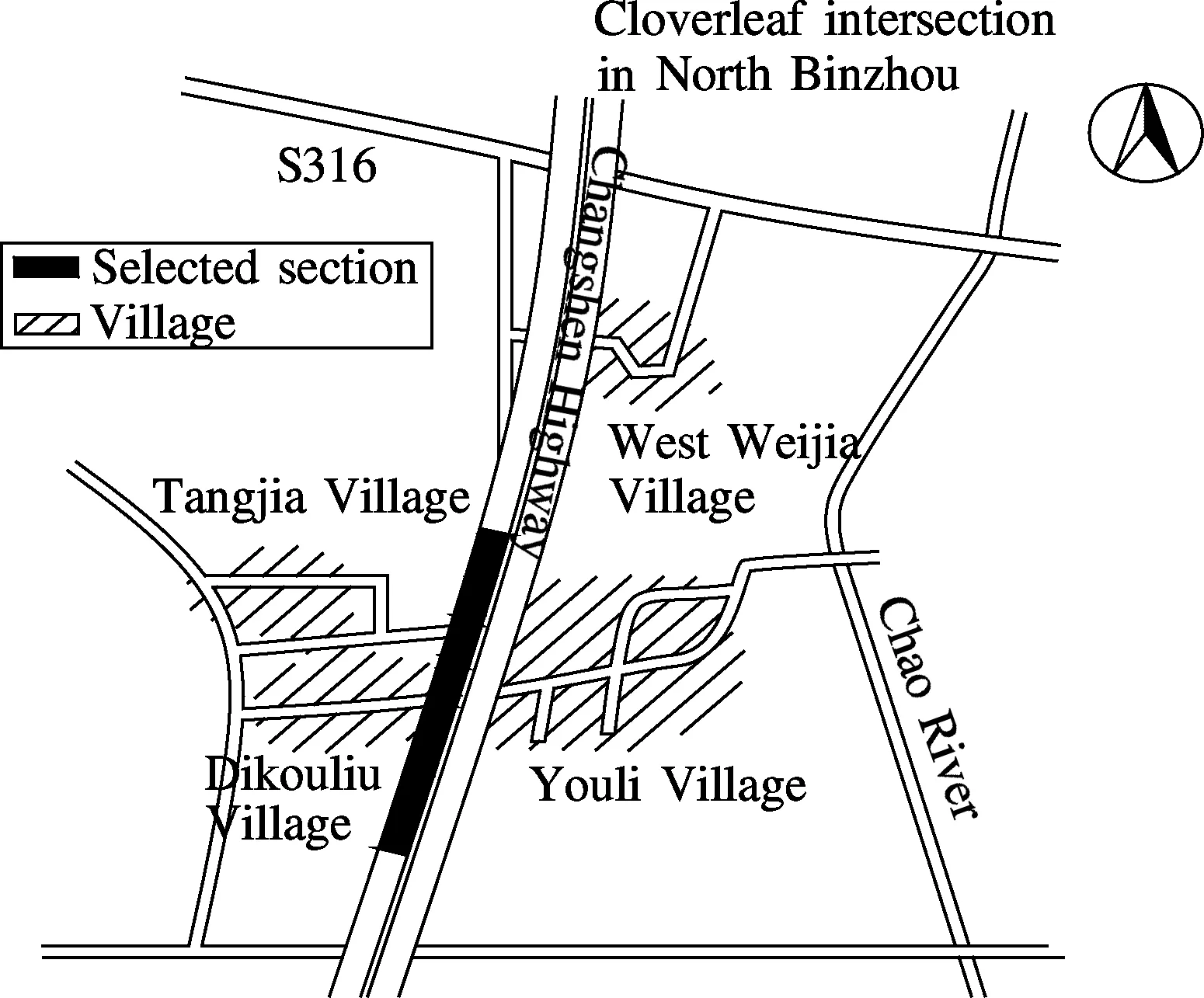
Fig.1 Map of the monitored road
The study site is located in Binzhou section of Changshen highway. The road section is 400 m long, from K1 276+990 to K1 277+390 (see Fig.1). The section is selected according to the following factors: surroundings, typical climate, the traffic load and the characteristics of lanes. The site is located in the rural residential district of Binzhou city where highway traffic is the only source of heavy metals and highway runoff contains heavy metals which contaminate water closely related to people’s daily lives. The site has two lanes (4.5 m wide each) with a marginal strip (3 m wide each) on each side and the surface is asphalt concrete pavement. Average daily traffic (ADT) load is 19 566 veh/d. The longitudinal slope and cross slope of the road section are 0.9% and 2%, respectively. There is a drainage hole every 25 m, and water drains off by drainage holes when runoff occurs on the road. Sampling is done at the drainage holes. The climate type of Binzhou is temperate continental monsoon. The mean annual rainfall is 598 mm. The rainy season falls between June and September with 456.1 mm rainfall, which makes up 74.2% of the total annual rainfall.
1.2 Sampling
There are 16 drainage holes in the selected road. In order to achieve quality control in analytical experiments, six drainage holes were selected as sampling points with the equidistant sampling method. According to the rain intensity and discharged runoff load, grab samples were collected at 5 to 10 min intervals after the first runoff outflow from the rainspout. The first five samples were collected every 5 min, and then every 10 min until the end of the event. Water samples were stored in l L polyethylene bottles. Every bottle was soaked in nitrate acid solution and rinsed three times with distilled water before use. The rain gauge was installed near the sampling site to record the characteristics of each rainfall. To analyze the adsorption characteristics of road surface particles before and after the rainfall event, six sampling points were selected to collect road particles. Each particle sampling point was 2 m long. Particles accumulated at 0.5 m from the road shoulder were collected by vacuum.
To assess the removal efficiency of the road sweeper, field sweeping experiments with different sweeping frequencies were carried out. The particles on the road surface were collected.
1.3 Analysis
The preservation of the samples and water quality measurements follow the standard methods specified by China State Environment Protection Agency (SEPA)[15]. Reagent-grade chemical products and ultra-pure water are used through the analysis. Suspended solids (SS), copper (Cu), cadmium (Cd), lead (Pb) and zinc (Zn) were determined in laboratory.
The samples for heavy metals analysis were digested with HNO3acid and determined through flame atomic absorption spectrophotometer for Cu and Zn, and graphitic furnace atomic absorption spectrophotometer for Pb and Cd. The samples were filtered by 0.45 μm filter membranes to analyze dissolved heavy metals (Cu, Cd, Pb, and Zn).
Finally, the particle-size distribution and heavy metals adsorption characteristics are analyzed. The particles were sieved through different stainless-steel test sieves: 2 000, 1 000, 500, 250, 125 and 63 μm. The different size fractions were weighed after they had been sieved. The samples of different sizes were digested with mixed acid of HNO3, HF and HClO4[15], and then determined through flame atomic absorption spectrophotometer for Cu, Cd, Pb and Zn. The metal concentrations of road particles were calculated.
2 Results and Discussion
2.1 Discharge rules of heavy metals in highway runoff
2.1.1 Flushing characteristics of heavy metals
Total heavy metal concentrations consist of dissolved and particulate heavy metals. The peak concentrations of Cu, Cd, Pb and Zn appear at the initial stage of a rainfall (5 min after the emergence of road runoff). As shown in Fig.2, the peak concentrations of Cu, Cd, Pb and Zn are 100.0, 4.78, 167.6 and 1 210.4 μg/L, respectively. The concentrations of Cu and Zn exceed standard grade Ⅴ and Ⅲ, respectively[16], which indicate serious pollution of Cu and Zn. The concentrations of heavy metals drop to a lower value, accounting for 1/5 to 1/8 of the initial concentrations in runoff after 1.5 h since the emergence of road runoff, and the first flushing effect is evident. After 0.5 h since the emergence of road runoff, the second concentration peak of heavy metals appears, which is due to the intense rainfall accumulated on the road surface that increases the flow rate and enhances the erosion capacity of runoff on coarser particles. The concentrations of heavy metals decrease at 0.5 h after the emergence of runoff and increase slightly before the end of the rain, which is consistent with the rainfall characteristics.
There are significant differences between the results obtained by this study and by Li et al.[17]who researched on the wash-off rules of heavy metals in low-intensity rainfall events. The reasons for the differences are that the rainfall intensity in this study is high, and heavy rainfall causes high road runoff. Rainfall intensity reaches a peak at the initial stage of the rain, and the scouring action of runoff is strong. Fine particles accumulated on pavement are washed by the runoff, and heavy metals adsorbed to the particles are washed into the runoff as well. The particles washed into runoff decrease as fine particles accumulated on the road surface are reduced by the duration of the rain. The concentrations of heavy metals in road runoff continue to decrease until the end of the rain. Gan et al.[18]found that the concentrations of heavy metals would rebound at a later stage as the vehicles continuously generate pollutants on the road during rain events. However, there is a peak at the end of the rain in this study. The concentrations of heavy metals are diluted by the runoff, and the concentrations of heavy metals decrease without a rebounce.
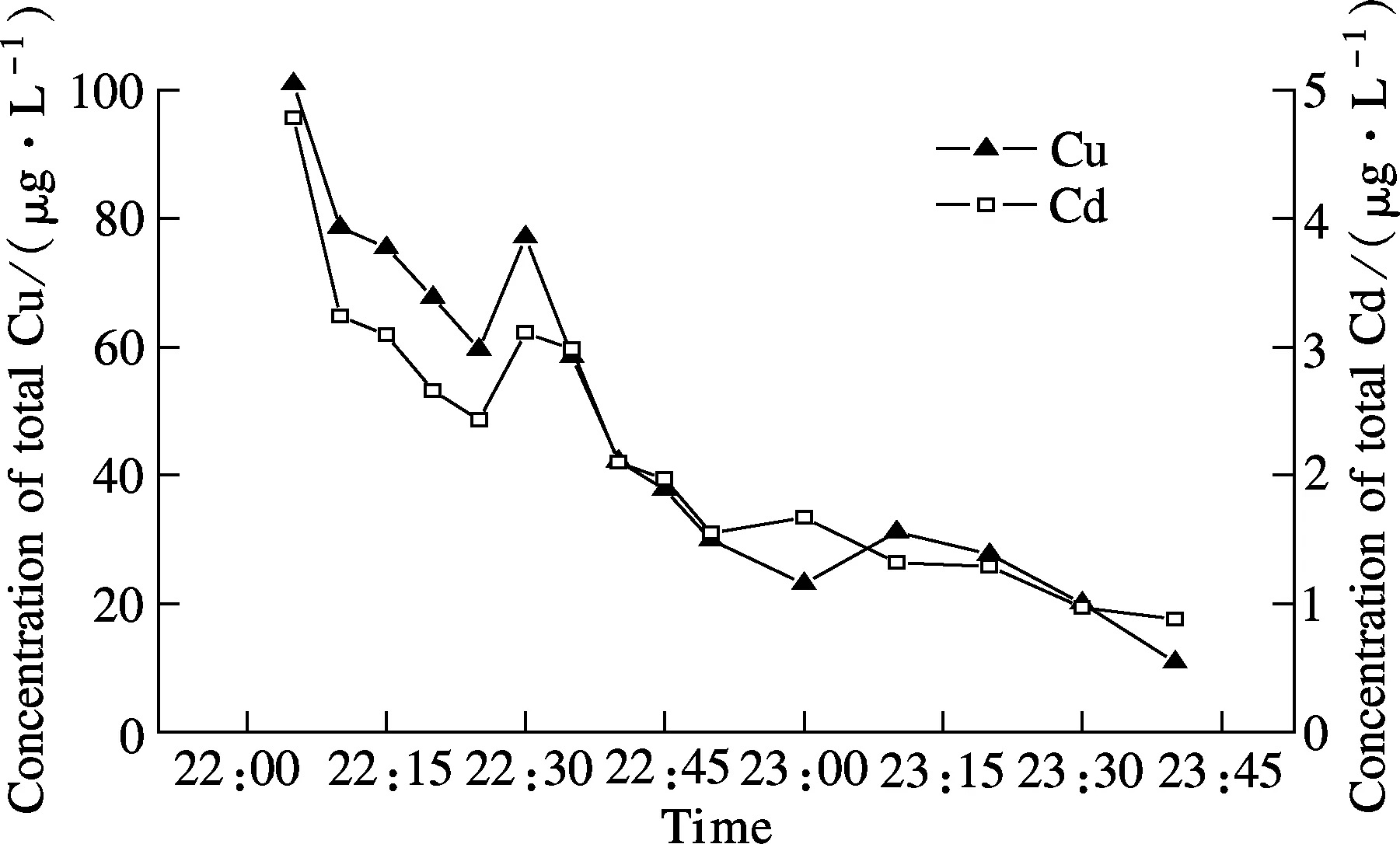
(a)
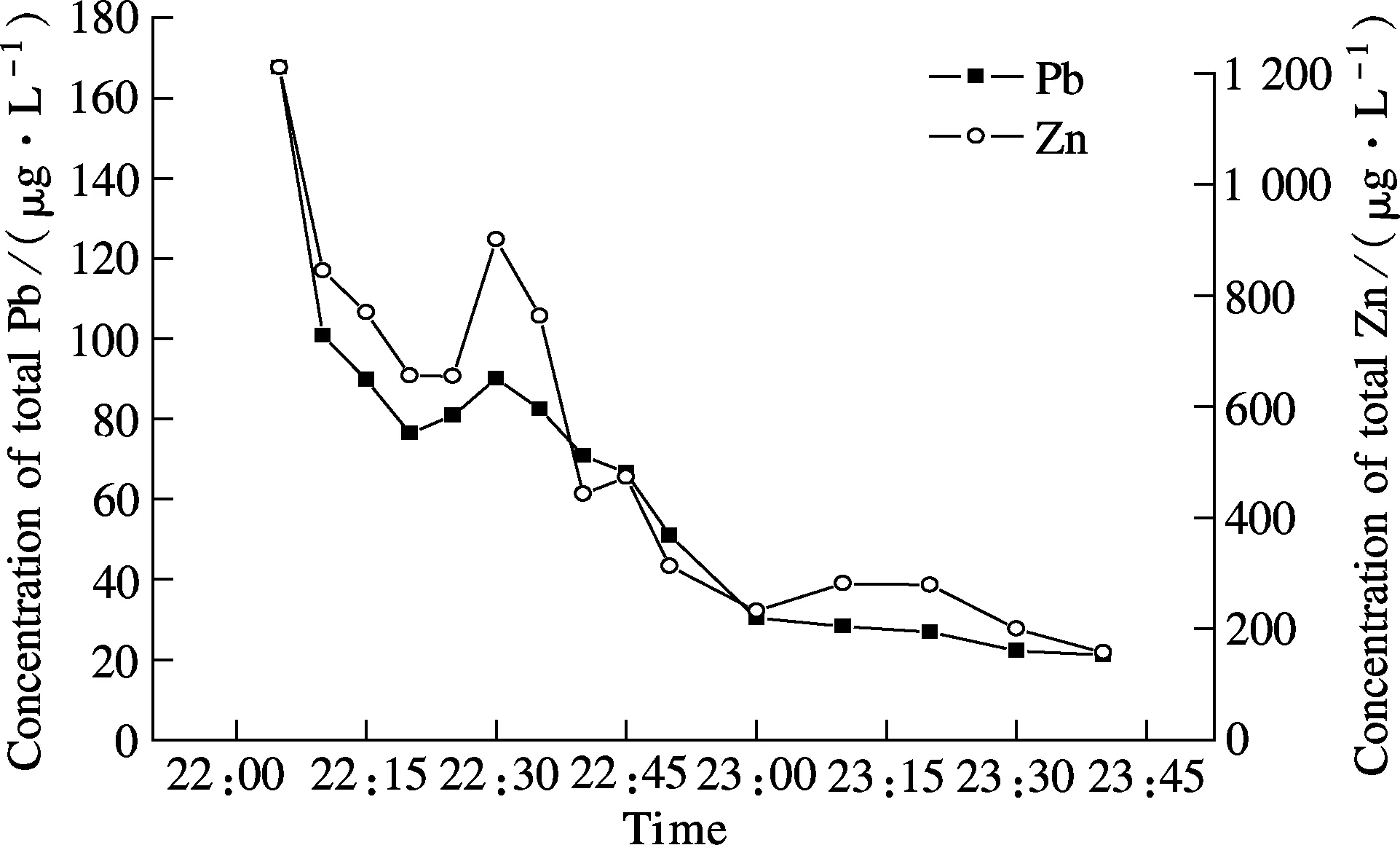
(b)
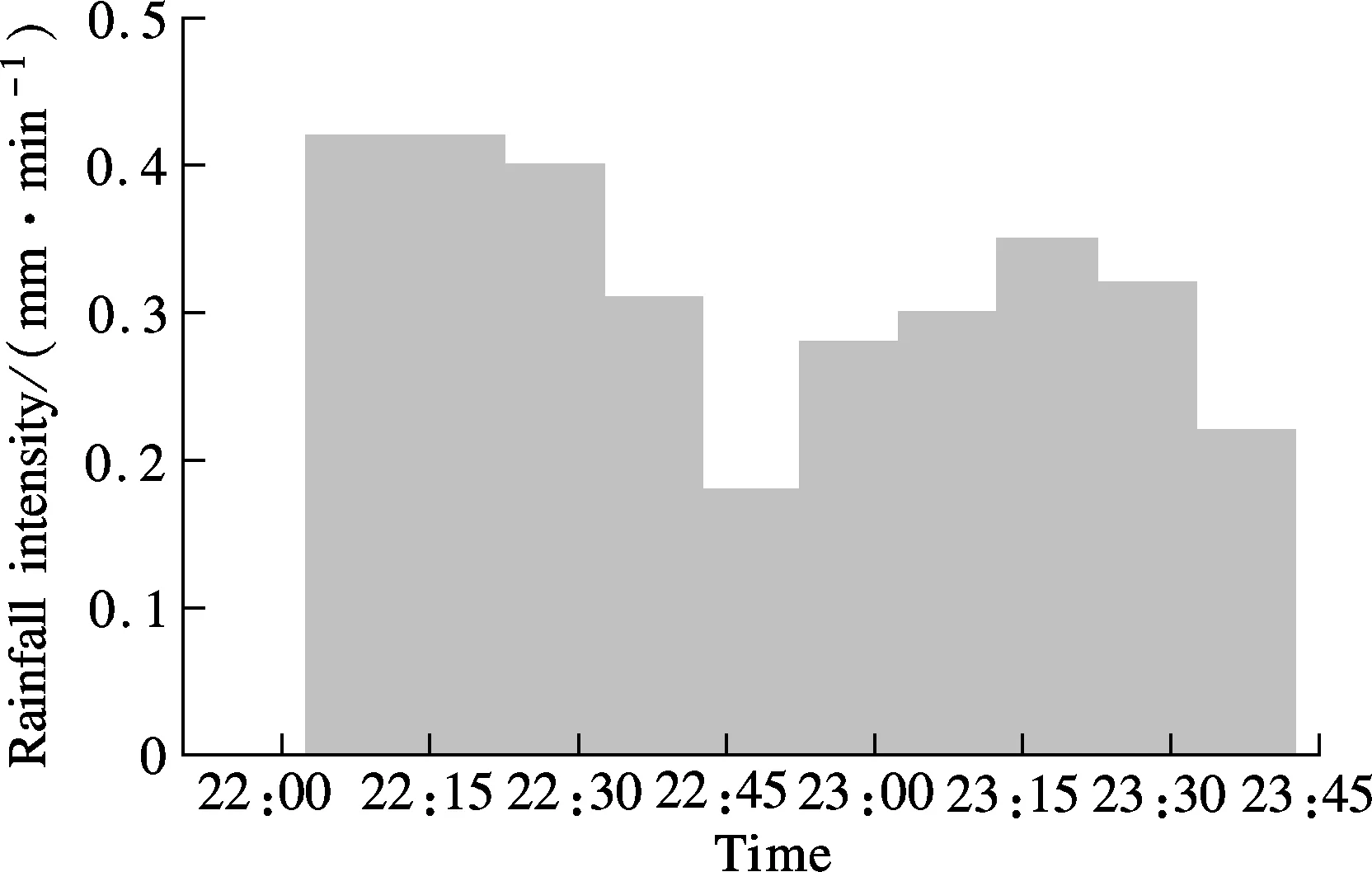
(c)
2.1.2 Existing characteristics of heavy metals
Based on the results of instantaneous water samples, the event mean concentrations (EMCs) of total heavy metals and dissolved heavy metals are calculated[19]. EMC can reflect the overall pollution levels of road runoff, and the relationships between the dissolved heavy metals and those at the particulate phase in the whole rainfall event can be defined with this index. EMC is calculated as
whereMis the total load of heavy metals washed by runoff;Vis the total runoff;c(t) is the concentration of heavy metals varing by time;q(t) is the flow rate; andtris the total runoff duration. Limited by objective conditions, the road runoff flow rate is not measured in this study. However, the beginning time of the rainfall and the emergence time of the runoff are recorded to eliminate the lag between rainfall and road runoff. In addition, the highway pavement is paved with asphalt, and the percolation and evaporation of rainfall are negligible. The EMC of pollutants in road runoff is calculated using rainfall weight instead of runoff rate. The results are shown in Tab.1.

Tab.1 EMC of heavy metals μg/L
The percentage of dissolved Cu, Pb and Zn are 33.2%, 10% and 36%, respectively. It is obvious that dissolved heavy metals in road runoff account for a large proportion of total loads, and the control of dissolved heavy metals plays an important role in controlling the heavy metals pollution in road runoff. Dissolved heavy metals originate from desorption of heavy metals from road particles[20]. Hares et al.[10-11]found that the removal efficiency of control measures was lower than the designed value due to the fact that artificial wetlands and other control measures cannot effectively remove dissolved heavy metals.
2.2 Heavy metal loads adsorbed to road particles before and after rainfall event
2.2.1 Size distribution
Road runoff scours and entrains particles, especially fine particles. The particles sampled before and after rainfall are analyzed to compare the differences between them (see Tab.2).
Tab.2 Particles distribution and wash effect of road runoff on particles before and after rainfall
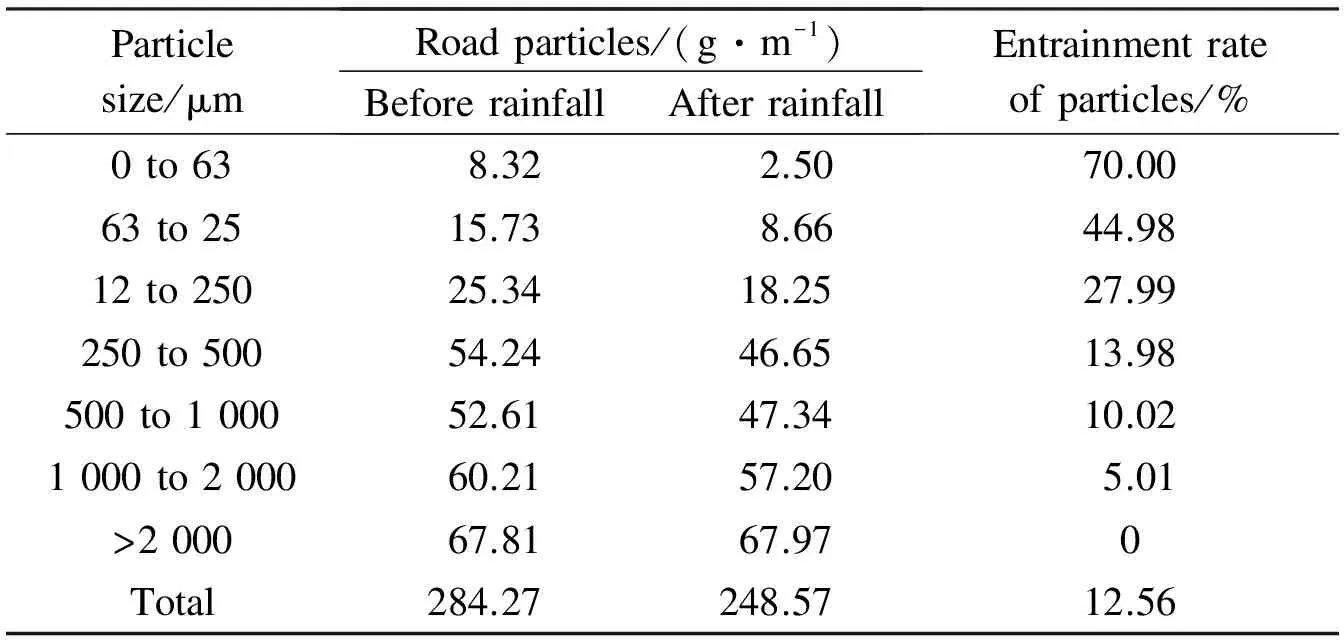
Particlesize/μmRoadparticles/(g·m-1)BeforerainfallAfterrainfallEntrainmentrateofparticles/%0to638.32 2.5070.0063to2515.738.6644.9812to25025.3418.2527.99250to50054.2446.6513.98500to100052.6147.3410.021000to200060.2157.205.01>200067.8167.970Total284.27248.5712.56
Tab.2 demonstrates that the entrainment effects of runoff bring a more significant impact on particles finer than 63 μm and particles between 63 and 125 μm than those of others (see Tab.2). The cumulative masses of the finest fractions (<63 μm) and the fractions between 63 and 125 μm change from 8.32, 15.73 to 2.50, 8.66 g/m after the rainfall event, respectively, and the entrainment rates of runoff are 70% and 45%, respectively. Particles smaller than 125 μm are generally predicted to be poorly trapped by runoff control measures[21]. The particle entrainment rate gradually drops with the increase in particle size. Only 5% of particles between 1 000 and 2 000 μm are entrained into runoff, while particles bigger than 2 000 μm are not entrained into road runoff.
If developed sweepers that can effectively remove particles smaller than 125 μm are used for road sweeping, SS will be reduced from the source. As a result, the pollutant loads of runoff pollution control measures will be reduced, and ideal control efficiency can be achieved.
2.2.2 Desorption of heavy metals from road particles
Heavy metals desorb from particle surfaces as a result of runoff erosion and mutual friction between particles and water. The desorption rate is calculated by changes in heavy metal adsorption loads on road particles sampled before and after rainfall. The reduction rates of Cu, Pb and Zn adsorbed to the particles of different sizes vary a lot. Heavy metal leaching loads increase with the increase in particle size. The leaching load of Zn is much higher than those of Cu and Pb. The total adsorption load of Zn is 1 021 mg/kg, which is much higher than those of Pb and Cu.
The accumulation mass of particles significantly increases as particle size increases (see Tab.2), so does the desorption of the heavy metals from particles (see Tab.3). Obviously, the contribution of coarse particles to dissolved heavy metals is much greater than that of the fine-grain. Therefore, if coarse particles can be effectively removed, the purpose of controlling dissolved heavy metals can be achieved.
Tab.3 Variations of heavy metals adsorption amount on particle surfaces before and after rainfall
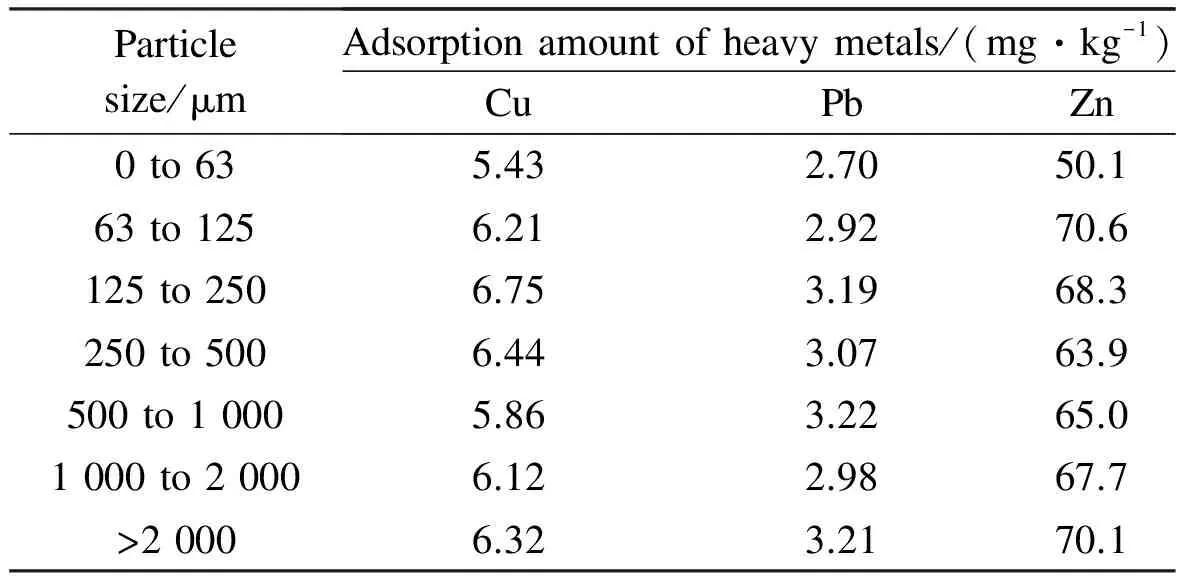
Particlesize/μmAdsorptionamountofheavymetals/(mg·kg-1)CuPbZn0to635.432.7050.163to1256.212.9270.6125to2506.753.1968.3250to5006.443.0763.9500to10005.863.2265.01000to20006.122.9867.7>20006.323.2170.1
2.2.3 Factors affecting the adsorption and desorption of heavy metals
Factors that cause metals to leach into rainfall runoff include pavement residence time, runoff pH, the nature and extent of entrained particles, the rainfall intensity and the solubility of the metal element. Pavement residence time influences the desorption time of metals. The longer particles contact with runoff, the more metals desorb from particles. The effects of pH on heavy metal desorption are in the following aspects: constraint solubility of heavy metals, influence on the adsorption properties of colloidal particles, and control of adsorption reactions on particle surfaces. Particle size is another important factor, as large particles have a smaller surface area, which reduces the contact opportunities between heavy metals and runoff. Rainfall intensity has a significant influence on heavy metal desorption, and high intensity rainfall performs strong shear force, resulting in an increase in heavy metal desorption mass. The solubility of the metals is directly dependent on the compounds with which they are associated. A typical species of compound metals includes organic compound, inorganic compound, colloidal compound, surface bound metals and particle lattice metals.
2.3 Efficiency of road sweeping as a control measure for dissolved heavy metals
2.3.1 Particle removal efficiency of road sweeping
Road sweeping efficiency is affected by the accumulated mass of particles, especially the removal of fine-grain. The removal rate of road sweeping on chronic accumulation particles is high (see Fig.3). The removal rates of 1 d accumulation particles which are smaller than 63 μm and particles between 63 and 125 μm are -120.56% and -42.52%, respectively. These particles are not removed by road sweeping. On the contrary, both of them increase after road sweeping. The removal rates of 3 d and 5 d fractions smaller than 63 μm are 14.02% and 18.35%, respectively. The removal rate of 7 d particles is as high as that of chronic particles. Road sweeping has a good performance on removing particles accumulated in a period of more than 7 d.
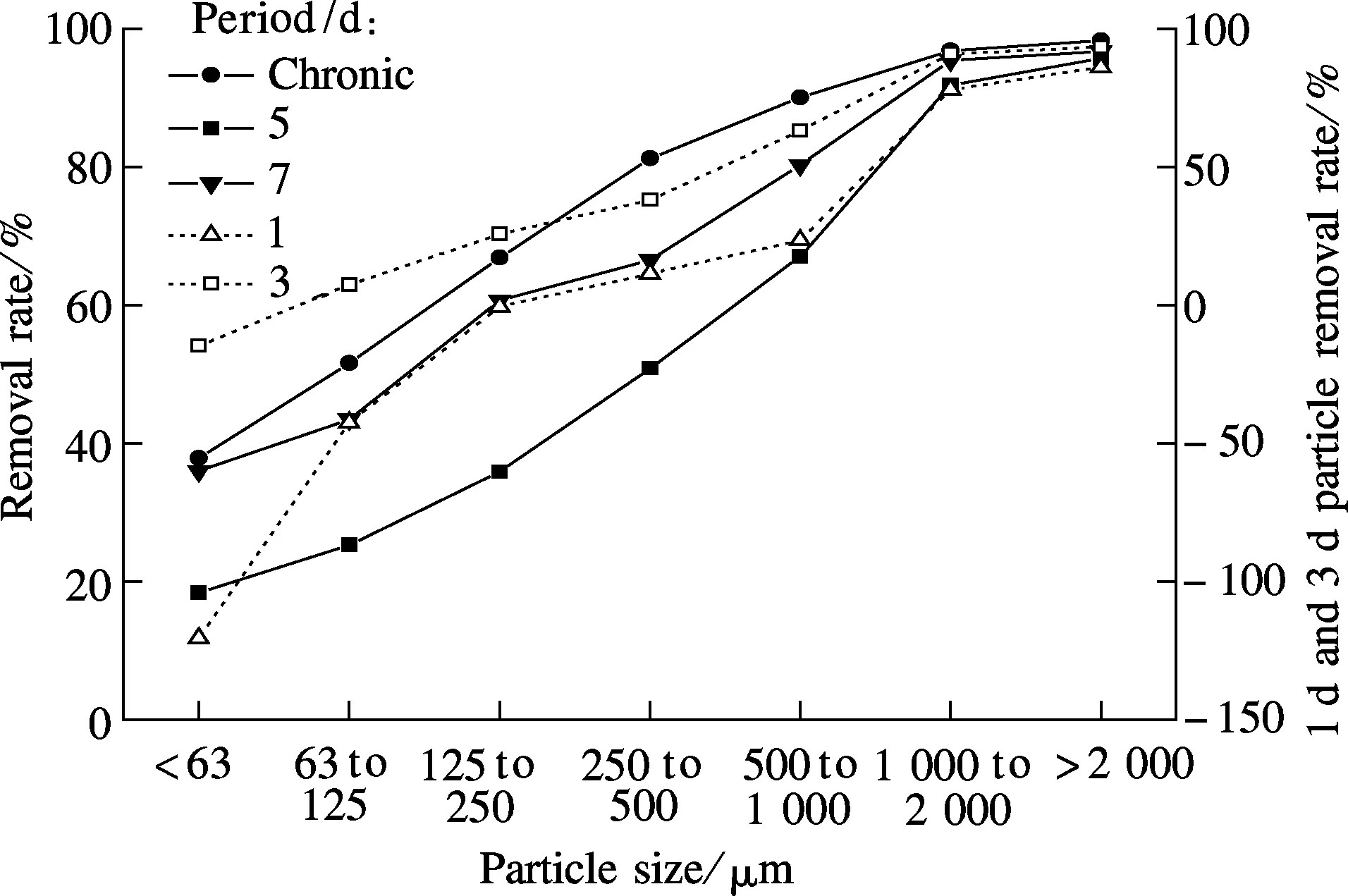
Fig.3 Removal efficiency of road sweeper
Removal rate and total amount control should be taken into account when evaluating the efficiency of road sweeping. Road sweeping achieves a high removal rate for chronic accumulation particles; but the residual amount after sweeping is much more than the other four build-up durations. A long sweeping internal is invalid for runoff pollution control. Road particles become much less with higher sweeping frequency, but there are some negative impacts exerted by high sweeping frequency. First of all, high sweeping frequency will increase the cost of sweeping. Secondly, road sweeping does damage to the roads. In addition, when the removal efficiency is certain, the contribution of increasing sweeping frequency to enhancing removal efficiency will be reduced greatly. It is cost-effective to choose an appropriate sweeping frequency.
The removal rates of particles accumulated in 1, 3 and 5 d are much lower than those of chronic particles in this study. These three sweeping frequencies are inappropriate. The removal efficiency of particles accumulated in 7 d is close to that of chronic particles. Residual amount after sweeping is 19.68 g/m. The residual amount after sweeping of particles accumulated in 3 and 5 d are 18.56 and 15.43 g/m. In summary, a period of 7 d is a proper sweeping interval.
2.3.2 Prediction on efficiency of road sweeping as a control measure for dissolved heavy metals
Based on different sweeping methods, a prediction equation is established to calculate the pollution control efficiency of sweeping measure. The heavy metals decrement can be calculated as
where Δρis the decreased value of pollutant concentrations in runoff after road sweeping; ΔMis the total decrement of pollutants;Vis the road runoff volume;Piis the sweeping efficiency of road sweeper on various sized particles; Δciis the variation of pollutants adsorbed to particles;miis the accumulation mass of various sized particles.
The removal efficiency of road sweeping which is calculated by heavy metals decrement in runoff divided by EMCs is shown in Tab.4.
Tab.4 Removal efficiency of street sweepers for dissolved heavy metals

Sweepinginterval/dRemovalefficiency/%CuPbZn14.684.604.42317.2516.8516.06529.1528.5327.06747.9346.8744.21
It may bring significant benefits to adopt the sweeping measure every week (see Tab.4). However, there may be little incremental benefit of sweeping at shorter intervals. Daily sweeping keeps the pollutants on the road surface at a lower level, but it is not cost-effective, and the removal rate is very low.
3 Conclusions
1) The initial heavy metal concentrations are high, which exhibits a pronounced first flush. The maximum concentrations of Cu, Cd, Pb and Zn are 100.9, 4.78, 167.6 and 1 210.4 μg/L, respectively. There are significant differences of heavy metal discharge rules in various districts and various rainfall events.
2) Total heavy metals in runoff consist of dissolved heavy metals and particulate heavy metals. The EMCs of dissolved Cu, Pb and Zn account for 33.2%, 10% and 36% of the total EMC, respectively. Runoff pollution control measures perform less satisfactorily as designed, which is a result of low removal efficiency of dissolved heavy metals.
3) The size distribution of road particles and pollutant loads adsorbed to particles can be changed by road runoff. Coarse particles make a bigger contribution to dissolved particles than that of fine fractions.
4) Road sweeping keeps particles accumulated on the road at a low level, and it is an effective measure to control dissolved heavy metal pollution. Weekly sweeping is more cost-effective than the other three sweeping frequencies.
[1]Li He, Shi Junqing, Shen Gang, et al. Characteristics of rainfall runoff discharges rule caused by heavy metals on express highway [J].JournalofSoutheastUniversity:NaturalScienceEdition, 2009, 39(2): 345-349. (in Chinese)
[2]Gupta K, Saul A J. Specific relationships for the first flush load in combined sewer flows [J].WaterResearch, 1996, 30(5): 1244-1252.
[3]Li L Q, Yin C Q, Kong L L, et al. Effect of antecedent dry weather period on urban storm runoff pollution load [J].EnvironmentScience, 2007, 28(10): 2287-2293.
[4]Shinya M, Tsurubo K, Konishi T, et al. Evaluation of factors influencing diffusion of pollutant loads in urban highway runoff [J].WaterScienceTechnology, 2003, 47(7/8): 227-232.
[5]Lee H, Lau S L, Masoud K, et al. Seasonal first flush phenomenon of urban stormwater discharges [J].WaterResearch, 2004, 38(19): 4153-4163.
[6]Lee J Y, Kim H J, Kim Y J, et al. Characteristics of the event mean concentration (EMC) from rainfall runoff on an urban highway [J].EnvironmentalPollution, 2011, 159(4): 884-888.
[7]Zhao Jianqiang, Liu Shan, Qiu Liping, et al. The characteristics of expressway runoff quality and pollutants discharge rule [J].ChinaEnvironmentalScience, 2001, 21(5): 445-448. (in Chinese)
[8]Terzakis S, Fountoulakis M S, Georgaki I, et al. Constructed wetlands treating highway runoff in the central Mediterranean region [J].Chemosphere, 2008, 72(2): 141-149.
[9]Revitt D M, Shutes R B E, Jones R H, et al. The performances of vegetative treatment systems for highway runoff during dry and wet conditions [J].ScienceoftheTotalEnvironment, 2004, 334-335: 261-270.
[10]Hares R J, Ward N I. Comparison of the heavy metal content of motorway stormwater following discharge into wet biofiltration and dry detention ponds along the London Orbital (M25) motorway [J].TheScienceoftheTotalEnvironment, 1999, 235(1/2/3): 169-178.
[11]Kayhanian M, Suverkropp C, Ruby A, et al. Characterization and prediction of highway runoff constituent event mean concentration [J].JournalofEnvironmentalManagement, 2007, 85(2): 279-295.
[12]Sutherland R C, Jelen S L, Minton G. High efficiency sweeping as an alternative to the use of wet vaults for stormwater treatment [C]//AdvancesinModellingtheManagementofStormwaterImpacts. Guelph, Canada: CHI, 1998, 6: 351-372.
[13]Sartor J D, Gaboury D R. Street sweeping as a water pollution control measure: lessons learned over the past ten years [J].TheScienceoftheTotalEnvironment, 1984, 33(1/2/3/4): 171-183.
[14]Malmquist P A. Atmospheric fallout and street cleaning-effects on urban storm water and snow [J].ProgressinWaterTechnology, 1978, 10(5/6): 495-505.
[15]China State Environment Protection Agency.Determinationmethodsforexaminationofwaterandwastewater[M]. Beijing: China Environmental Science Press, 2002: 435. (in Chinese)
[16]China State Environment Protection Agency. GB 3838—2002 Environmental quality standards for surface water[S]. Beijing: China Environmental Science Press, 2002. (in Chinese)
[17]Li He, Shi Junqing, Shen Gang, et al. Characteristics of rainfall runoff discharge rule caused by heavy metals on express highway [J].JournalofSoutheastUniversity:NaturalScienceEdition, 2009, 39(2): 345-349. (in Chinese)
[18]Gan Huayang, Zhuo Muning, Li Dingqiang, et al. Characteristics of heavy metal pollution in highway rainfall runoff [J].UrbanEnvironmentandUrbanEcology, 2007, 20(3): 34-37. (in Chinese)
[19]Li He, Zhang Xue, Gao Haiying, et al. Characterization of contaminated runoff on free way surface [J].ChinaEnvironmentalScience, 2008, 28(11): 1037-1041. (in Chinese)
[20]Chen Qiao, Hu Weiping, Zhang Jianning. Advances in research on the build-up and rainfall runoff wash-off of urban surface pollutants [J].ResourcesandEnvironmentintheYangtzeBasin, 2009, 18(10): 992-996. (in Chinese)
[21]Zanders J M. Road sediment: characterization and implications for the performance of vegetated strips for treating road run-off [J].ScienceoftheTotalEnvironment, 2005, 339(1/2/3): 41-47.
路面清扫控制高速公路径流重金属污染效果的预测
王 琳1卫宝立1冯美军1,2
(1中国海洋大学环境科学与工程学院,青岛 266100) (2山东省交通厅公路局,济南 250001)
以长深高速滨州段作为研究对象,分析路面清扫措施对高速公路径流污染的控制效果.通过现场取样分析公路径流中重金属Cu,Cd,Pb和Zn的出流规律,计算出径流中Cu,Pb和Zn的事件平均总浓度和溶解态浓度以及降雨前后路面颗粒物重金属吸附量的变化;同时利用清扫车进行现场清扫实验,获得不同清扫频率下路面清扫对颗粒物的去除率.结合径流污染特性和路面清扫结果建立径流污染控制效果预测公式,并对路面清扫控制径流污染的效果进行预测,结果表明,清扫频率为1次/周时,路面清扫对溶解态Cu,Pb和Zn的去除率分别可达47.93%, 46.87%和44.21%.
公路径流;污染物吸附;路面清扫;预测
X522
The National Science and Technology Major Project of China (No.2008ZX07010-008-04).
:Wang Lin, Wei Baoli, Feng Meijun. Prediction on effectiveness of road sweeping for highway runoff pollution control[J].Journal of Southeast University (English Edition),2014,30(2):255-260.
10.3969/j.issn.1003-7985.2014.02.022
10.3969/j.issn.1003-7985.2014.02.022
Received 2013-10-21.
Biography:Wang Lin (1966—), female, doctor, professor, lwangouc@126.com.
猜你喜欢
杂志排行
Journal of Southeast University(English Edition)的其它文章
- Stormwater management of urban greenway in China
- Development,assessment and implementation of integrated stormwater management plan:a case study in Shanghai
- Household model of rainwater harvesting system in Mexican urban zones
- Testing and analysis of rainwater quality in Shenyang
- Pollution control of outfall of rainwater-sewage confluence in old town
- Persistent toxic substances in urban highway runoff in Shanghai
